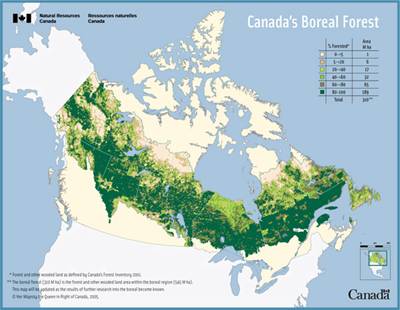I don’t usually pass these things along, but this email caught my eye:
—–
With last week’s Intergovernmental Panel on Climate Change report concluding that humans are significantly increasing global warming, we’re all looking for some global warming news with a glimmer of hope and potential. To our North, Canada is on the brink of deciding whether to protect its northern Boreal Forest in Canada — one of the world’s last defenses against global warming — or to continue on developing a ticking carbon bomb. Fortunately, recent mid-term elections in both Canada and the United States provide opportunities to address global warming.
As we here in the United States begin to tackle policies related to global warming, please urge Canada to do its part by protecting the Boreal Forest.

Little known to most of the world, Canada’s Boreal Forest is Earth’s carbon treasure: it is one of our most important tools in fighting global warming — if we protect it. The Boreal Forest is the largest unspoiled ecosystem on the planet and the world’s largest terrestrial storehouse of carbon.
Left intact, the Boreal Forest holds the greatest amount of carbon of any terrestrial ecosystem per unit area, storing up to two times as much carbon per acre as tropical forests and similarly can store more per unit area than temperate forests. Not only is the carbon stored in trees but the Boreal Forest’s extensive peat lands and forested wetlands are significant carbon sinks. If disturbed, however, these same qualities rank the Boreal Forest as one of the planet’s great, potential carbon emitters. Increased energy development and logging and disturbed soils associated with a range of boreal development have the potential to release vast stores of carbon.
The Boreal Forest is under development pressure from all sides; timber, mining and energy. But recently Canada has super-sized its development in the Boreal Forest as its beefed up quest for ‘energy super power’ status: Alberta’s Tar Sands are second only to Saudi Arabia as the world’s largest oil reserve and a 700-mile gas pipeline through the pristine Boreal Forest is being fast-tracked to fuel expansion of these Tar Sands (the world’s dirtiest and most polluting fuel). Tar Sands emissions will soon be on par with all the auto emissions in California. With only 10 percent of the Canadian Boreal Forest under protection, increasing development threatens to release greenhouse gases at an alarming rate.
On both sides of the border, the timing is ripe for evaluating resources and working together to protect the Boreal Forest’s future. While new Congressional leadership works towards global warming and related issues like oil company subsidies, across the border in Canada, the Conservative government led by Prime Minister Stephen Harper is expected to face an early election after only a year in office. This is largely due to his failure to address environmental issues, including global warming.
As the United States gathers the political will to tackle global warming, please urge our Canadian neighbor to also back a real global warming solution by protecting the Boreal Forest. The Canadian Boreal Forest presents hope and a solid line of defense against global warming for all North Americans.
—–
The alert comes from:
- Steve Kallick, Program Director, International Boreal Conservation Campaign, (206) 905-4800, skallick@pewtrusts.org.
- Lisa McCrummen, (206) 321 9461, lisa@creativethink.net or Aurah Landau, (907) 723-0241, aurah@borealbirds.org, media support for the International Boreal Conservation Campaign.
- Stewart Elgie, Professor, University of Ottawa, Faculty of Law, Associate Director, Institute of the Environment (613) 562-5800, ext 2525, Stewart.Elgie@uottawa.ca
- Susan Casey-Lefkowitz — Natural Resources Defense Council, sclefkowitz@nrdc.org, 202-289-2366

